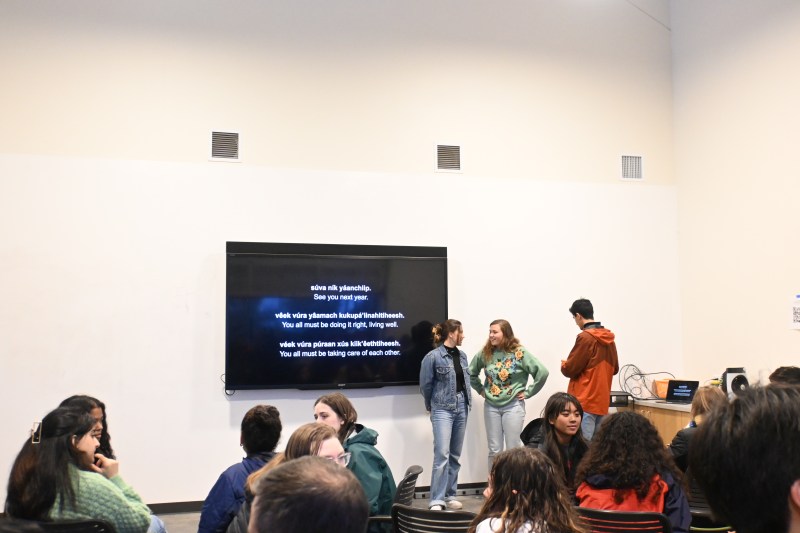The Understory Collective, a collaboration between Stanford students, Karuk land stewards and artists, launched on Feb. 3 at the O’Donohue Family Stanford Educational Farm. The Collective, which sells non-fungible token (NFT) art to fund conservation, restoration and land-back, marked its launch with a conversational event about prescribed burning.
Nearly 100 students were present at the event, during which Karuk tribal leaders, artists and prescribed fire practitioners spoke about the significance of fire for the Karuk people. Some attendees who were new to The Understory Collective were given informational packets and others purchased Karuk stewardship-inspired art in solidarity with the Collective’s efforts.
The collaborative project, run by Tule Horton M.S. ’23, Eric Bear M.S. ’23 and Sam Seaton M.A. ’23, aims to spread awareness about Indigenous practices, particularly prescribed burning. Prescribed burning, an Indigenous practice to intentionally set fire, has managed and restored forests for thousands of years.
Prescribed fires target the underbrush and small trees, where less carbon is stored, according to the National Science Foundation. Removing the underbrush minimizes the chances of wildfires and protects large carbon-storing trees. Anticipating California wildfires to be 50 percent more prevalent by 2050, the Understory Collective claims California must burn 20 million acres of land to minimize the risk and damage of severe fires, according to its website.
“We need to go back to what works, and what works is what has worked in this place for thousands of years: the use of fire as the primary management tool [for forests],” said Leaf Hillman, the Director of Natural Resources and Environmental Policy for the Karuk Tribe in a video played by the Understory Collective at the beginning of the event. “Fire is our medicine.”
The video made by Karuk Media entitled “pananu’thívthaaneen xúus nu’êethtiheeshabout: We’re Caring for Our World” focused on the importance of fire in Karuk history and culture. After the video screening, audience members discussed what fire means to them and how their conception of fire may have shifted after listening to Karuk land stewards.
“I hope people take away an understanding of the interconnectedness and importance of fire to California and California’s peoples and the way in which a healthy forest is one that has fire,” Horton said. “I think it’s a misconception that a lot of Californians have that fire is dangerous because we know it through scary experiences and evacuations, but in fact, fire is nature, fire is medicine and fire is culture.”
Following the discussion, the Karuk Department of Natural Resources led a virtual panel on cultural fire and Indigenous stewardship. Vikki Preston – a Karuk cultural resources technician, land steward and artist – spoke about her relationship with land and fire and the inspiration for her art, which was featured at the event and can be purchased as an NFT.
“I feel like art is a big source of cultural transmission in this area,” Preston said. “The inspiration for a lot of [my] pieces were created for different prescribed burning events.”
The event shed light on the role of fire in nature conservation. Stephanie Fischer, first-year Ph.D. in Earth Systems Science, gained a brand-new understanding of prescribed burns. “I am from New York, so I’m not familiar with fire as a hazard. I want to learn from an indigenous perspective.”
Hannah Melville-Rea, a first-year Ph.D. student in the Emmett Interdisciplinary Program in Environment and Resources, said she came to the event because she was curious. A student from Australia, Melville-Rea knew about similar land-back movements for Indigenous Australians and said she wanted to learn about parallels in California.
Other attendees expressed their support through donations. By purchasing posters and stickers created by Preston, students donated to the Eco-Cultural Revitalization Fund. This fund was set up by the Karuk tribe in 2016 to steward the land according to Karuk cultural knowledge and beliefs, support Karuk forests, fish and wildlife, educate Karuk youth and buy back historically Karuk land.
Seaton, a member of the Pueblo of Isleta tribe in New Mexico, said she was excited to see a wide range of students at the event –– individuals involved with Indigenous rights, environmental justice and people who were learning about the importance of prescribed burns for the first time. “It makes me really happy for more people to learn more about Native practices that have always been here.”
